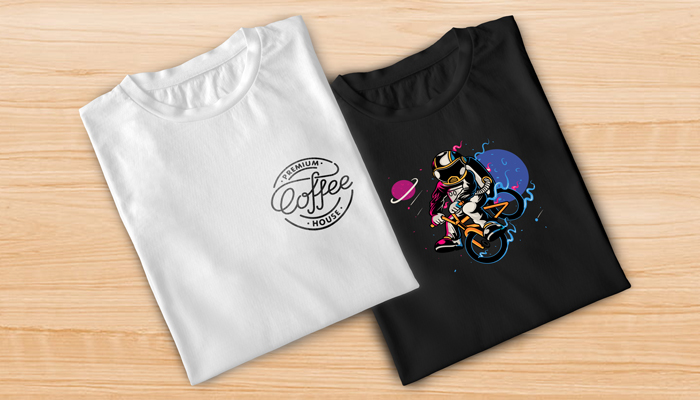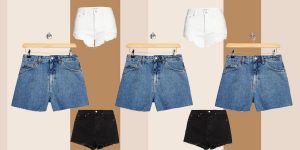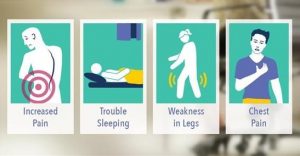
Direct-to-garment (DTG) printing and embroidery are options for transforming blank apparel into custom pieces that fit your needs. Both can look fantastic in their own right, resulting in unique garments for everyone, from shoppers to employees. Whether you need the clothing for a big event like a family reunion or you plan on selling it in your store, understanding the differences can help you decide which option is better. Read on for information about how they are different and how, in some ways, they are similar.
Sewn-on vs. printed on
The most apparent difference between embroidery and DTG printing is that the former involves applying thread to the fabric, while the latter has a design printed onto the material. DTG printing puts ink right onto the material, resulting in a flat design, usually on flat material. Embroidery has more texture, producing a raised (or 3D) completed design.
Thickness of the material
Designs can be printed on materials that vary in thickness. These can range from lightweight t-shirts like the Bella + Canvas unisex textured jersey v-neck tee to thicker pullover sweatshirts.
Embroidery usually requires heavier material, like hoodies or polos, to adequately hold the design. Material that is too lightweight compared to the design’s weight may result in puckering, causing the design not to look its best.
Material composition
Natural fibers, such as 100% cotton, tend to get preference over synthetics for use in embroidery and DTG printing. It is one of the few factors where there is equality between the two, even with their significant differences.
Textures
Speaking of materials, the flatter the fabric, the cleaner the look of the DTG print design. The more textured the material, the more it affects the completed look. For example, you can print the same design on a smooth cotton t-shirt and a cotton cable knit sweater, but the design will look more precise on the t-shirt than on the sweater.
Embroidery can go on flat or textured fabrics. Textured materials may require the embroiderer to adjust the design to stand out better rather than seeming like it is falling into the material or distorted.
Design complexities
It can be challenging to embroider overly-complex designs. It is one of the reasons you will often see simple-yet-elegant embroidered designs, such as a name on the upper left chest area of a shirt or a flower design on the hip of a pair of pants. Wording, such as the name of an employee or a company, monograms, and logos are three popular embroidered designs. Each embroidery company may have limitations about the size of the design they will do and the complexities of it.
DTG printing is an excellent option for creating complex designs, including large-scale ones on the front or back of shirts. There are usually few restrictions regarding a design’s complexity, but there may be recommendations for adjustments based on the combination of size, overall design, and material. In addition, printing companies have photo resolution requirements to ensure the finished design looks excellent on the clothing item.
The scale of the designs
There are size limits for DTG printing, but it can vary between companies according to the equipment they use. The design must fit within the clothing item’s parameters and be aligned to avoid looking off-center from the surrounding area. It also should not look unintentionally distorted. In some cases, shrinking it to a smaller size can make it look even better.
Embroidered designs are usually small. Many designs are 5 inches or less, but it may be possible to do larger ones depending on the business you use. Companies typically have limits on the size of embroidered designs they will do, especially in some clothing regions.
Colors
Embroidered designs typically do not involve a lot of colors. It is common to see designs that feature only a few colors or less, just enough to create a design like a logo or a name. Ask the business doing the embroidery how many thread colors they offer and if they have hues available that you want in your specific design.
It is easy to do vibrant graphic prints with DTG printing. There is typically no limit to how many shades you can use for the design, even if it involves multiple colors. The process can include everything from printing phrases in a single color to multi-colored photos.
Shiny special effects
One of the reasons many like embroidery is that the thread can have a slight shine, especially once the design is complete and you get a good look at it in the light.
Metallic printing foil is one of the most exciting effects that bring shine to a DTG-printed design. However, adding the shine is performed after printing by using a heat press. It can give a full-scale shine to the design, which can look fantastic in contrast to clothing in varying colours, predominantly white or black.
Fading
Embroidery thread is durable and stays intact. A slight bit of fading will likely result in a long-term, high-quality look.
DTG printed designs may eventually fade, especially with an incorrect process or not washing the finished products according to the instructions. Therefore, ensuring the company has a stellar reputation for high-quality results and that the clothing gets washed according to the printing company’s instructions is crucial.
Which is the better option, Direct-to-garment printing, and Embroidery?
DTG printing and embroidery are vastly different, so generally, one is not better. It is about what would be best for the design you have in mind.
For example, DTG printing is ideal for a large-scale design on the front of a t-shirt, but you may find you prefer the professionally raised look of an embroidered design for a small logo.
Only some companies offer both embroidery and DTG printing. If you have a specific business you usually work with that does not provide the required service, you may have to team up with another company for your current clothing design needs.
Regardless of whether you choose DTG printing or embroidery, speak with your company of choice. Doing so can give you a breakdown of how the project would work and its total costs while also allowing you to learn more about which option would be best for your project.

